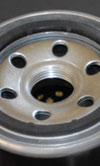The Oil Filter
 Of all the components in a typical oil system, the function and hence usefulness of the oil filter in a modern racing engine must surely be one for review. Designed to separate the larger particles which somehow accumulate in the oil and prevent them from returning back into the engine, there is little doubt that in most roadgoing vehicles some kind of filter may be necessary. In a racing engine however, which is put together under the cleanest of conditions and then assembled into the chassis in workshops where quite frankly, I would be happy to eat my dinner straight off the floor, why do we have to introduce another kilo or so of additional hardware, extra seals and so forth, when surely the technology exists to make sure that non of these foreign bodies find their way into the oil system in the first place?
Of all the components in a typical oil system, the function and hence usefulness of the oil filter in a modern racing engine must surely be one for review. Designed to separate the larger particles which somehow accumulate in the oil and prevent them from returning back into the engine, there is little doubt that in most roadgoing vehicles some kind of filter may be necessary. In a racing engine however, which is put together under the cleanest of conditions and then assembled into the chassis in workshops where quite frankly, I would be happy to eat my dinner straight off the floor, why do we have to introduce another kilo or so of additional hardware, extra seals and so forth, when surely the technology exists to make sure that non of these foreign bodies find their way into the oil system in the first place?
Now before you start to think that I'm some sort of crackpot with a grudge against the filter manufacturers, I've done my homework. Once many years ago I had occasion to run a series of tests on an engine with the oil filter removed. The tests, part of a research project into engine wear using radioisotopes, were conducted in an engine dynamometer test cell, monitoring the build up of radioactivity in the oil due to the minute quantities of wear that was taking place in the top ring reversal point on one of the cylinders. At first we ran a traditional set up monitoring the build up of radioactivity in both the oil and filter, but for some reason, the exact details of which have long been forgotten, it was necessary to remove the filter and continue testing purely monitoring the condition of the oil.
Testing continued apace with a series of tests each lasting up to ten hours of wide open throttle running on a proprietary 1600cc gasoline engine. After each test the oil was carefully drained, flushed and replenished with a new, slightly different test lube. Altogether we must have completed some 15 or more tests with very strong and repeatable radioactive wear signals coming from the oils. Altogether with flushing cycles and warm up cycles, the engine must have covered 200 or more hours of quite arduous testing, but it was at the cessation of testing when we received our greatest shock. Once the engine had cooled down and had been carefully stripped adopting all the usual techniques and safety precautions necessary for handling (only very slightly) radioactive engine components, there was no visible evidence of wear of any sort on any of the critical parts. Wear there most obviously had been since we had monitored it during the tests and confirmed it using more sensitive off-line radioactive measurements. And the wear we had monitored in the oil signal was greater than we had measured in the oil during earlier tests when the filter was still in the line.
The conclusion to all this was while the filter was obviously trapping some wear debris, when removed, that debris was retained in the oil no doubt held in suspension by the detergents but it didn't do any harm to the engine overall. The tests were short (less than 10 hours) and the oil changes were made under ideal conditions, so why can't we do the same with our sprint car engines and dispense with the oil filter? Discuss.
Fig. 1 - A typical oil filter.
Written by John Coxon